

How do we reconstruct climate?
Story Lines:

Key words: Glacial Epochs, Inter-glacial periods, Milankovitch cycles, The Little Ice Age, Heinrich Events
We often give names to climatic fluctuations:
The Little Ice Age - A cool period from 1400 to 1860 A.D which was characterized by harsh winters, shorter growing seasons, and a drier climate. The Little Ice Age has been blamed for a host of human suffering including crop failures like the "Irish Potato Famine."
Medieval Warm Period - A warm spell from approximately A.D. 1000 to A.D. 1350 that existed just prior to the Little Ice Age.
Holocene Maximum - .
Younger Dryas - A cold spell 21,000 years ago named after a arctic-alpine plant "Dryas" that populated Europe during the cold conditions.
Kargian Warm Period - around 42,000 to 25,000 years ago.
Industrial Age Global Warming - Our present day warm cycle that began
in the late 1800's.
Why Study Past Climate Systems?
When we see pictures of dinosaurs basking in tropical heat or wooly mammoths shivering in an ice-covered tundra, how do we know that they lived in such climates? We can tell indirectly from sediments and deposits laid down during these periods. For example, the presence of tropical plant and animal remains at the polar latitudes indicate that significantly warmer conditions must have existed as compared to today. Conversely, the absence of tree pollen in the tundra probably means that conditions were too cold for trees to grow.
Climate change affects ecosystems today, as it has in the past. By exploring past climate change, its magnitude and rapidity, we obtain a basis to understand how future climate change may influence our environment. Plants are directly affected by climate, and vegetation changes in turn are important for animals that feed on them. If we can discover and understand the links between climate and ecosystems of the past, we have a better chance of understanding current change and predicting the future.
During the last 3 million years glaciers have at one time or another covered about 29%
of Earth's land surface or about 17.14 million square miles. What did not lay
beneath ice was a largely cold and desolate desert landscape, due in large part to the
colder, less-humid atmospheric conditions that prevailed. Summers were short and winters
were brutal. Animal life and especially plant life had a very tough time of it. Thanks to
global warming, that has all now changed, at least temporarily.
The World 18,000 Years Ago
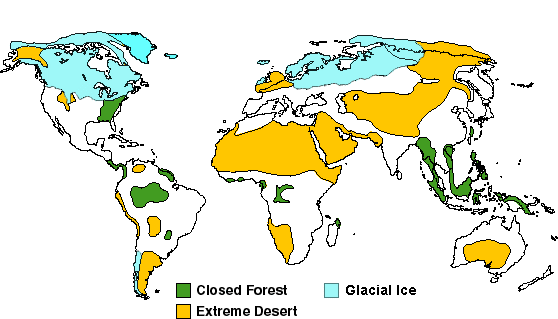
Our Present World
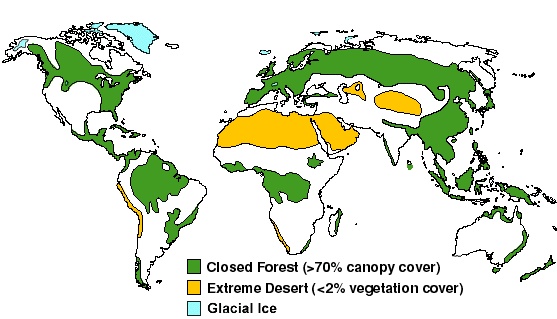
Our Fluctuating Climate

Compiled by R.S. Bradley and J.A. Eddy based on J.T. Houghton et al., Climate Change: The IPCC Assessment, Cambridge University Press, Cambridge, 1990 and published in EarthQuest, vo. 1, 1991.
Courtesy of Thomas Crowley,
The Earth's climate was in a cool period from A.D. 1400 to about A.D. 1860, dubbed the "Little Ice Age." This period was characterized by harsh winters, shorter growing seasons, and a drier climate. The decline in global temperatures was a modest 1/2° C, but the effects of this global cooling cycle were more pronounced in the higher latitudes. The Little Ice Age has been blamed for a host of human suffering including crop failures like the "Irish Potato Famine."
Today we enjoy global temperatures which have warmed back to levels of the so called "Medieval Warm Period," which existed from approximately A.D. 1000 to A.D. 1350.
What is the Earth's Climate Record?
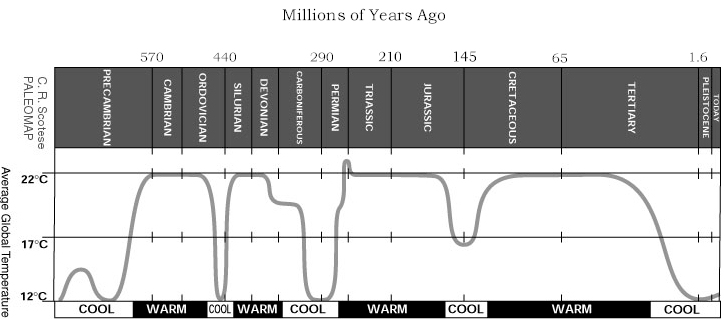
The Geologic History of Ice Ages

For most of the time, the Earth was probably warmer than it is at present, with little or no polar ice. However, at infrequent intervals, the rock record shows signs of extensive glaciation. At least four major Ice Ages have been recognized within Precambrian times, although rock that ancient tends to be metamorphized to the extent that evidence of glaciation is difficult to find.
The Gondwanan Ice Age at 300 million years corresponds to the period when the continents were collected together in a supercontinent called Pangaea.
What causes Climate Change?
Although the basic causes of climate change are still not fully understood, many clues have been collected. Possible causes include:
(1) Tectonic Causes
- Landmass distribution: Shifting continents (continental drift) causing changes in circulatory patterns of ocean currents. It seems that whenever there is a large land mass at one of the Earth's poles, either the north pole or south pole, there are ice ages.
- Undersea ridge activity: "Sea floor spreading" (associated with continental drift) causing variations in ocean displacement.
(2) Astronomical Causes
- 21,000 year cycle: Elliptical orbit of the Earth around the Sun (precession of the equinoxes)
- 41,000 year cycle: Cycle of the +/- 1.5° wobble in Earth's orbit
- 100,000 year cycle: Variations in solar energy output
(3) Atmospheric Causes
- Heat retention: Due to gases such as carbon dioxide and methane in Earth's atmosphere-- the "greenhouse effect"
- Solar reflectivity: Due to clouds, volcanic dust, polar ice caps
We can also separately consider climate changes over several different time scales:
Long Term Climate Changes (millions of years) - Our best guess today is
associated with the very slow process known as "Plate Tectonics" and its
influence on the atmospheric greenhouse effect. Over the time scale of 300 million
years (back to the last known Great Ice Age - the Gondwanan), the continental plates have
moved greatly. The question remains as to why the temperatures dropped. Perhaps the
answer lies in changes in the natural (non-biogenic) production rate of carbon dioxide -
the number one greenhouse gas. We know that CO2 is produced in volcanoes and in
the mid-ocean trenches. It is lost by being slowly absorbed in the oceans. Both of these
processes are very slow - about the right time scales to explain the great Ice Ages.

One theory is that carbon dioxide is produced by a faster rate of sea-floor spreading
and an subsequent increase in vulcanism and During times of rapid spreading, the
higher volcanic activity, coupled with higher ocean levels and reduced chemical weathering
of rocks, may promote global warming by enriching the CO2 content of the
atmosphere. Similarly, global cooling may result from stalled or slowed spreading
The medium term climate changes includes the semi-regular advances and retreats of the glaciers during an individual Ice Age. The last 2.8 Ma have been marked by large global climate oscillations that have been recurring at approximately a 100,000 yr. periodicity at least for the past 800,000 years. The warm periods, called interglacial periods, appear to last approximately 15,000 to 20,000 years before regressing back to a cold ice age climate.
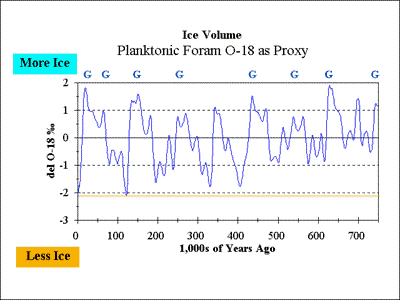

Climate Fluctuations in Our Present-Day Interglacial Period

So far in the past 18,000 years, the earth's temperature has risen approximately 16 degrees F and the sea level has risen 300 feet.
The best clue for explaining these changes comes from a consideration of the Milankovitch cycles, changes in the orbital characteristics of the Earth. The basic premise of the theory is that, as the Earth travels through space, three separate cyclic movements combine to produce variations in the amount of solar energy falling on the Earth.
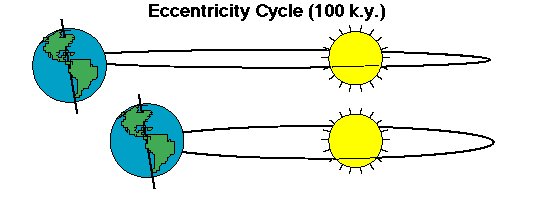
It turns out that the Earth's orbit goes from quite elliptical to nearly circular in a cycle with a period of ~100,000 years. Presently, we are in a period of low eccentricity (~3%) and this gives us a seasonal change in solar energy of ~7%. When the eccentricity is at its peak (~9%), the "seasonality" reaches ~20%. In addition a more eccentric orbit will change the length of seasons in each hemisphere by changing the length of time between the vernal and automnal equinoxes
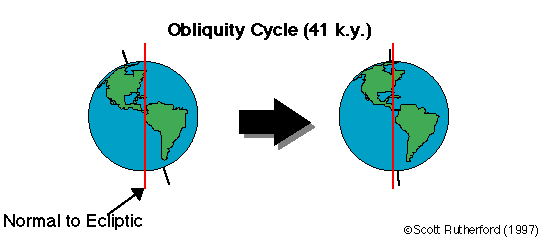
The second Milankovitch cycle takes about 41,000 years to complete and involves changes in tilt (obliquity) of the Earth's axis (Figure 10). Presently the Earth's tilt is 23.5o, but the 41,000 year cycle varies from ~22o to 24.5o. The smaller the tilt, the less seasonal variation there is between summer and winter at middle and high latitudes.
For small tilt, the winters would tend to be milder and the summers cooler. This would lead to more glaciation.
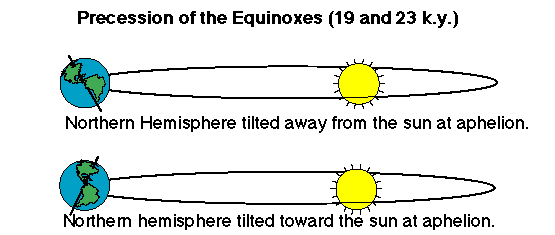
The third cycle is due to precession of the spin axis (as in a spinning top) and occurs over a ~23,000 year cycle. Presently, the Earth is closest to the Sun in January and farther away in July. Due to precession, the reverse will be true in ~11,000 years. This will give the Northern Hemisphere more severe winters.
When all the Milankovitch cycles (alone) are taken into account, the present trend should be towards a cooler climate in the Northern Hemisphere, with extensive glaciation. The Milankovitch cycles may help explain the advance and retreat of ice over periods of 10,000 to 100,000 years. They do not explain what caused the Ice Age in the first place.
Other factors which work in conjunction with the Earth's orbital changes include:
How Fast Can Climate Change?
Short Term Changes (decades to hundreds of years)
Driving factors: Ocean circulations, volcanic eruptions, solar variations, greenhouse gases,
Modern Changes

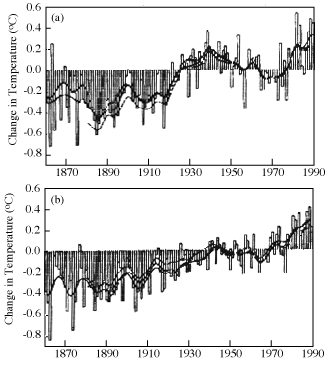
It has long been thought that the great Ice Ages came and went on time scales measured in thousands of years, and less momentous changes--such as the Holocene Maximum or the Little Ice Age--over the span of several centuries. Current studies and more recent paleodata have revealed quite another face of the climate system, called "abrupt transitions," in which major shifts in some components of the Earth's climate are accomplished on time scales of decades or less.
Initially proposed, and later verified, was the revolutionary notion that the large-scale circulation in the North Atlantic could persist in one of two patterns, or states, both of which were quite stable, with the possibility of abrupt switching between the two. In the first, the warm Gulf Stream that flows along the eastern coast of the U.S. continues northward, reaching beyond the British Isles to the Norwegian Sea, ameliorating the climate of northwest Europe. James Joyce aptly referred to this condition in Ulysses, when he wrote that "All Ireland is washed by the Gulf Stream."
In the other possible mode, the northward extension of the Gulf Stream is weakened by a reduction in the salinity of surface waters in high latitude regions of the North Atlantic. With less salt, seawater is not as dense, and is less able to sink during normal wintertime cooling. Restricting the ability of the North Atlantic to circulate water downward limits the amount flowing in from the warm Gulf Stream. The result of this "short-circuit" in ocean circulation is a much cooler climate for all who live downstream, including Northern Europe.
The surprising evidence from the paleoclimate record is how quickly the switch between warm and cold states can be accomplished. Evidence from ice-age portions of recent Greenland ice cores suggests that changes of this sort may have taken place in the past in the span of five to ten years. These abrupt transitions are most likely linked to an increase in the release of icebergs from continental glaciers, which on melting contribute large volumes of freshwater into the ocean, systematically reducing the local salinity.
Whatever the cause, we now know that in at least the North Atlantic the climate system can change very rapidly. Might ocean circulation change as rapidly in the future, perhaps as a consequence of other significant changes in the system? The answer is "maybe." There are no permanent ice sheets today on the North American continent, as was the case in the past, but melting of Arctic sea ice or the extensive Greenland ice cap could well influence ocean salinities. Increased precipitation over the North Atlantic, induced by warmer temperatures, could also reduce the saltiness of seawater, short-circuiting the ocean circulation in a manner similar to what occurred during the ice ages.
Ocean currents and temperature patterns in the Pacific Ocean also play an important role in regulated our climate. Recent research has revealed a decadal oscillation in the Pacific Ocean that can effect climate across the United States. Positive phases enhance the occurrence of El Nino events and negative phases increase the occurance of La Nina events. These oceanic and atmospheric patterns can have a large impact on marine and terrestrial ecosystems.

Future Scenarios
 As long as the continent of Antarctica exists at the
southern pole of our planet we probably will be repeatedly pulled back into glacial ice
ages. This occurs because ice caps, which cannot attain great thickness over open ocean,
can and do achieve great thickness over a polar continent-- like Antarctica. Antarctica
used to be located near the equator, but over geologic time has moved by continental drift
to its present location at the south pole. Once established, continental polar ice caps
act like huge cold sinks, taking over the climate and growing bigger during periods of
reduced solar output. Part of the problem with shaking off the effects of an ice age is
once ice caps are established, they cause solar radiation to be reflected back into space,
which acts to perpetuate global cooling. This increases the size of ice caps which results
in reflection of even more radiation, resulting in more cooling, and so on.
As long as the continent of Antarctica exists at the
southern pole of our planet we probably will be repeatedly pulled back into glacial ice
ages. This occurs because ice caps, which cannot attain great thickness over open ocean,
can and do achieve great thickness over a polar continent-- like Antarctica. Antarctica
used to be located near the equator, but over geologic time has moved by continental drift
to its present location at the south pole. Once established, continental polar ice caps
act like huge cold sinks, taking over the climate and growing bigger during periods of
reduced solar output. Part of the problem with shaking off the effects of an ice age is
once ice caps are established, they cause solar radiation to be reflected back into space,
which acts to perpetuate global cooling. This increases the size of ice caps which results
in reflection of even more radiation, resulting in more cooling, and so on.

A schematic reconstruction (solid line) of mean global surface temperature through the last 100 million years, based on analyses of various marine and terrestrial deposits. The dashed-line extension is a prediction of future trends through the coming 400 years, based on the assumption of substantial utilization of the fossil fuel reservoir. The vertical line shows the approximate range of surface temperature in climate model predictions for a doubling of CO2 levels, at about 100 years in the future. Modified from T. J. Crowley, Journal of Climate, vol 3, pp 1282-1292, 1990.
Paleodata of various kinds indicate that the Earth's climate prior to the last million years was considerably warmer. For almost all of the time from about 2 to at least 200 million years ago (Ma) the surface temperature exceeded that of today. The greatest warmth is found in what geologists call the Cretaceous Period, about 100 Ma, when the mean global surface temperature may have been as much as 6 to 8° C above that of today. This was followed by a fairly steady cooling, sometimes with abruptly stepped transitions, towards the unique glacial oscillations of the last few million years.
During most of this long period of time, and certainly from about 150 to 50 Ma, there is little evidence for ice sheets of continental scale, and subtropical plants and animals lived far poleward (almost 55-60° latitude) of their present limit of about 30°--the latitude of northern Florida. The Age of Dinosaurs, ending about 65 Ma, overlaps most of this warm interval, and fossilized remains of these large reptiles have been found on the North Slope of Alaska. Later, during the warmest part of the Age of Mammals (55 Ma), large trees grew in Arctic Canada (78°N), in regions that today are covered by tundra. Alligators and primates, also indicative of warm climate, have been found on nearby Ellesmere Island. Fossils of warm-water mollusks have also been recovered on the Antarctic Peninsula.